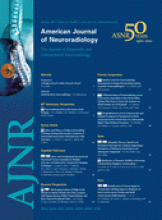Research ArticleNeurointervention
Patency of Branches after Coverage with Multiple Telescoping Flow-Diverter Devices: An In Vivo Study in Rabbits
D. Dai, Y.H. Ding, R. Kadirvel, A.E. Rad, D.A. Lewis and D.F. Kallmes
American Journal of Neuroradiology January 2012, 33 (1) 171-174; DOI: https://doi.org/10.3174/ajnr.A2879
D. Dai
Y.H. Ding
R. Kadirvel
A.E. Rad
D.A. Lewis

References
- 1.↵
- Lylyk P,
- Miranda C,
- Ceratto R,
- et al
- 2.↵
- Kallmes DF,
- Ding YH,
- Dai D,
- et al
- 3.↵
- Fiorella D,
- Kelly ME,
- Albuquerque FC,
- et al
- 4.↵
- Fiorella D,
- Woo HH,
- Albuquerque FC,
- et al
- 5.↵
- Sadasivan C,
- Cesar L,
- Seong J,
- et al
- 6.↵
- Nelson PK,
- Lylyk P,
- Szikora I,
- et al
- 7.↵
- Szikora I,
- Berentei Z,
- Kulcsar Z,
- et al
- 8.↵
- 9.↵
- Kallmes DF,
- Ding YH,
- Dai D,
- et al
- 10.↵
- Schwartz RS,
- Huber KC,
- Murphy JG,
- et al
- 11.↵
- Kulcsar Z,
- Ernemann U,
- Wetzel SG,
- et al
- 12.↵
- van Rooij WJ,
- Sluzewski M
- 13.↵
- Dai D,
- Ding YH,
- Kadirvel R,
- et al
- 14.↵
- Plenk H Jr.,
- Shum JC,
- Cruise GM,
- et al
In this issue
Advertisement
D. Dai, Y.H. Ding, R. Kadirvel, A.E. Rad, D.A. Lewis, D.F. Kallmes
Patency of Branches after Coverage with Multiple Telescoping Flow-Diverter Devices: An In Vivo Study in Rabbits
American Journal of Neuroradiology Jan 2012, 33 (1) 171-174; DOI: 10.3174/ajnr.A2879
0 Responses
Jump to section
Related Articles
- No related articles found.
Cited By...
- Predictors of the Effects of Flow Diversion in Very Large and Giant Aneurysms
- Long-term visual outcome in patients treated by flow diversion for carotid-ophthalmic aneurysms
- Use of flow diverters in the treatment of unruptured saccular aneurysms of the anterior cerebral artery
- Pipeline embolization device for the treatment of vertebral artery aneurysms: the fate of covered branch vessels
- Flow diversion treatment of complex bifurcation aneurysms beyond the circle of Willis: a single-center series with special emphasis on covered cortical branches and perforating arteries
- Posterior Inferior Cerebellar Artery Patency after Flow-Diverting Stent Treatment
- A New Aneurysm Occlusion Classification after the Impact of Flow Modification
- Flow diverter stents for unruptured saccular anterior circulation perforating artery aneurysms: safety, efficacy, and short-term follow-up
- Extra-Aneurysmal Flow Modification Following Pipeline Embolization Device Implantation: Focus on Regional Branches, Perforators, and the Parent Vessel
- Small Pipes: Preliminary Experience with 3-mm or Smaller Pipeline Flow-Diverting Stents for Aneurysm Repair prior to Regulatory Approval
- Visual Outcomes with Flow-Diverter Stents Covering the Ophthalmic Artery for Treatment of Internal Carotid Artery Aneurysms
- Building Multidevice Pipeline Constructs of Favorable Metal Coverage: A Practical Guide
- Pipeline Embolization Device in Aneurysmal Subarachnoid Hemorrhage
This article has been cited by the following articles in journals that are participating in Crossref Cited-by Linking.
- Matthias Gawlitza, Anne-Christine Januel, Philippe Tall, Fabrice Bonneville, Christophe CognardJournal of NeuroInterventional Surgery 2016 8 5
- J.P. Cruz, C. O'Kelly, M. Kelly, J.H. Wong, W. Alshaya, A. Martin, J. Spears, T.R. MarottaAmerican Journal of Neuroradiology 2013 34 2
- A. Rouchaud, O. Leclerc, Y. Benayoun, S. Saleme, Y. Camilleri, F. D'Argento, M.-P. Boncoeur, P.-Y. Robert, C. MounayerAmerican Journal of Neuroradiology 2015 36 2
- Andrea M Herrmann, Stephan Meckel, Matthew J Gounis, Leona Kringe, Edith Motschall, Christoph Mülling, Johannes BoltzeJournal of Cerebral Blood Flow & Metabolism 2019 39 3
- Marcus D Mazur, Craig Kilburg, Victor Wang, Philipp TausskyJournal of NeuroInterventional Surgery 2016 8 10
- Aditya Vedantam, Vikas Y. Rao, Hashem M. Shaltoni, Michel E. MawadNeurosurgery 2015 76 2
- G. Gascou, K. Lobotesis, H. Brunel, P. Machi, C. Riquelme, O. Eker, A. Bonafé, V. CostalatAmerican Journal of Neuroradiology 2015 36 4
- M. Shapiro, E. Raz, T. Becske, P. K. NelsonAmerican Journal of Neuroradiology 2014 35 8
- P Bhogal, R Martinez Moreno, O Ganslandt, H Bäzner, H Henkes, M Aguilar PerezJournal of NeuroInterventional Surgery 2017 9 3
- Christina Iosif, Yann Camilleri, Suzana Saleme, François Caire, Catherine Yardin, Sanita Ponomarjova, Marie-Paule Boncoeur-Martel, Charbel MounayerJournal of Neurosurgery 2015 122 3
More in this TOC Section
Similar Articles
Advertisement











